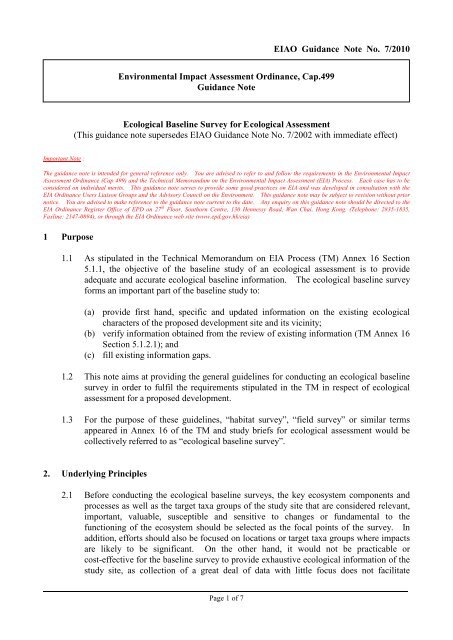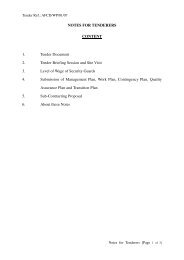Ecological Baseline Survey for Ecological Assessment
Ecological Baseline Survey for Ecological Assessment
Ecological Baseline Survey for Ecological Assessment
You also want an ePaper? Increase the reach of your titles
YUMPU automatically turns print PDFs into web optimized ePapers that Google loves.
subsequent ecological assessment.2.2 The ecological baseline survey aims at collecting ecological data through sampling. Theactual sampling ef<strong>for</strong>t would generally depend on the physical size of the site, diversityof the habitats, flora and fauna, seasonal variation of the target taxa groups under studyand availability of existing ecological baseline in<strong>for</strong>mation. The project proponent, inconsultation with environmental consultants where applicable, should determine theappropriate amount of sampling ef<strong>for</strong>t in each case based on their professionaljudgement and actual site situations. In all cases, there should be adequate samplings toensure that the data obtained are representative to address both spatial and temporalvariations. The sampling ef<strong>for</strong>ts (e.g. number and frequency of sampling, locations andtiming of surveys, etc.) and methods should be appropriately presented in the EIA report<strong>for</strong> audit purpose.2.3 <strong>Survey</strong> methods used should be scientifically robust and appropriate <strong>for</strong> the habitats andtarget taxa groups under study. Standardized survey methods should be appliedwherever appropriate so that results can be compared with those arising from otherstudies. If the methods used vary from accepted methods in order to meet the specificneeds of a study, the justifications and reliability of the results should be thoroughlypresented in the EIA report. The surveys should also be carried out by personnel withadequate knowledge and field experience of the target taxa groups to be surveyed.2.4 Besides recording the species of the target taxa groups at the site through sampling, thedominant flora and fauna as well as any species of conservation importance should alsobe noted. The ecological baseline survey should also aim at providing insight into theecological functions and importance of the habitats in question. For instance, during abird survey, any notable behaviour such as feeding, roosting or breeding of the birds andthe associated habitats and vegetation where they show such behaviours should berecorded. In fact, any special species-habitat relationships observed during the surveyshould be noted down. Such in<strong>for</strong>mation is relevant and essential <strong>for</strong> subsequentimpact identification, evaluation and mitigation.2.5 In essence, an ecological baseline survey aims at revealing the ecological profile of thestudy area to facilitate the subsequent impact assessment and mitigation. The EIAstudy brief may also stipulate additional requirements on the ecological baseline surveytaking into account the nature of the project, site conditions and valid concerns of thepublic. However, as each survey has its specific constraints and, probably, uniquecircumstances, it may not be possible nor appropriate to specify every single detail (e.g.the exact numbers, dates, routes, methodology, etc.) in the EIA study brief. Furtherinvestigations to address specific issues may be required during the course of the EIAstudy and be presented in the EIA report.3 Duration of <strong>Survey</strong>3.1 TM Annex 16, Section 5.1.4 states that the duration of an “ecological baseline survey”required shall be defined in the EIA study brief issued under the EIA Ordinance.3.2 The duration of an ecological baseline survey should be long enough <strong>for</strong> gathering thenecessary baseline data. Generally, the duration of an ecological baseline survey shouldPage 2 of 7
e commensurate with the scale of the proposed development at hand, and the durationspecified in the EIA study brief should be regarded as the minimum requirement.Representative in<strong>for</strong>mation could be obtained in a reasonable period of time ifappropriate survey and sampling methods are adopted. An unnecessarily longecological baseline survey may not yield useful additional in<strong>for</strong>mation but may imposedifficulties on the project proponent in terms of costs, programming and projectimplementation.3.3 The duration of an ecological baseline survey <strong>for</strong> a proposed development is generallydependent on the following factors:(a) the geographical coverage of the study area;(b) the diversity of habitats within the study area;(c) the diversity of flora and fauna within the study area;(d) presence of ecologically important species or habitats which exhibit distinctseasonal patterns (e.g. migratory animals, seasonal wetlands);(e) availability of existing ecological in<strong>for</strong>mation of the study area;4. Seasonality4.1 In accordance with the TM Annex 16 Section 5.1.4, an ecological survey of a longerduration with regard to seasonal variations may be required if the area in question islikely to be supporting species of conservation importance which exhibit distinctseasonal patterns or when in<strong>for</strong>mation on the site is inadequate.4.2 Hong Kong has a sub-tropical climate and hence does not have four distinct seasons.Typically, Hong Kong has a wet hot “summer” and a dry cool “winter”. (The averagemonthly temperature and rainfall are shown in Figures 1 and 2.) These two periodsmay be simply referred as “wet” season (April to October) and “dry” season (Novemberto March). However, April and October are regarded by some ecologists as transitionalmonths, the weather of which may not be typical <strong>for</strong> wet season and may vary from yearto year. These considerations should be taken into account when designing surveyprogramme and interpreting survey results.4.3 In the marine environment, there are also seasonal variations. During the wet season,the discharge of the Pearl River makes the western waters remarkably low in salinity(can be lower than 10 ppt) while the eastern waters remain oceanic (salinity generallyabove 30 ppt). In the dry season when the freshwater discharge is much reduced, mostof our waters are of rather uni<strong>for</strong>mly high salinity. There are also some differences inwater temperature and consequently dissolved oxygen levels between the two seasons.The range can be from under 10°C to over 30°C, and from less than 2 mg/L of dissolvedoxygen in wet season to over 8 mg/L in dry months.4.4 Different wildlife groups may differ in their activities and hence conspicuousness atdifferent times of the year, as a result of difference in breeding seasons, migratorybehaviour, or physiological changes (e.g. low temperature restricts activity ofpoikilotherms but not homeotherms). There<strong>for</strong>e, to obtain good results, a target taxagroup should be surveyed at the time of the year when the group is more active,conspicuous or easy to be identifiedPage 3 of 7
Data Source : Hong Kong Observatory Almanac, Hong Kong Observatory (2008)4.5 The recommended survey seasons <strong>for</strong> the target taxa groups that are usually included inecological baseline surveys are shown in Figure 3. It should be noted that the figureonly serves as a reference <strong>for</strong> the period of a year when different faunal or floral groupsare generally more conspicuous. The actual timing of survey may need to be adjusted ifa target species has special seasonal or diurnal pattern (e.g. egretry should be surveyedduring the breeding season of egrets and herons between March and August; it would bemore effective to conduct survey <strong>for</strong> amphibians at night time during wet season) or <strong>for</strong>special habitat types where certain target species groups are expected.Page 4 of 7
Figure 3: Time of the year to survey major floral and faunal groupsMonths J F M A M J J A S O N DWET SEASONVertebratesTerrestrialMammalsActive throughout the year, no distinct seasonalityMarineMammalsResident BirdsActive throughout the year, with seasonal distribution and abundanceActive throughout the yearOverwinteringBirdsWinter migrantsvisiting periodOversummeringBirdsSummer migrants visitingperiodPassageMigratory birdsPassage migrantsvisiting periodAmphibiansReptilesFreshwater FishActive period of most frog & toad speciesActive period of most reptile speciesActive period of most fish speciesInvertebratesButterfliesOdonatesHorseshoe CrabVegetationHigher PlantsOccurrence of flying adults of most speciesOccurrence of flying adults of mostspeciesActive period of juveniles in intertidalzone<strong>Survey</strong> period <strong>for</strong> most speciesPage 5 of 7
Types of <strong>Survey</strong> Period5.1 On the basis of the factors described in Section 3.3 above and the seasonal patterns oftarget taxa groups reviewed in Section 4.4 and 4.5, the duration of an ecological baselinesurvey required will be determined and defined in the study brief. A 4-monthecological baseline survey will generally be required as long as some ecological impactsare anticipated from the proposed development. More specific considerations inrespect of the determination of different survey durations are given below:(a)(b)(c)4-month survey• The study area consists of common habitats.• The 4-month period should provide reasonable amount of in<strong>for</strong>mation ongeneral wildlife use of the study area.• Some surveys in the wet season are necessary if there are stream courses orwetlands in the study area.6-month survey• The study area consists of relatively diverse habitats and species.• A certain extent of seasonal patterns in wildlife use of the study area isanticipated.• Some surveys in the wet season are necessary if there are streams courses orwetlands in the study area.9-month survey• The study area consists of diverse habitats and species.• A certain target species with marked seasonality is likely to be present in thestudy area.5.2 The above requirements could vary from case to case depending on the wildlife groupsand locations to be surveyed, and will be specified in the study brief issued under theEIAO. Having said that, in the event of a planning application has to be made inparallel, the project proponent is reminded of the Town Planning Board Guidelines <strong>for</strong>Application <strong>for</strong> Developments within Deep Bay Area under Section 16 of the TownPlanning Ordinance (TPB PG-No. 12B (Revised April 1999)), which also has a specialrequirement <strong>for</strong> field investigation normally covering a period of not less than 12months.6. <strong>Survey</strong> Programme6.1 The project proponent and environmental consultants shall make sure that the entireduration of survey specified in the EIA study brief is well covered to take into accountthe temporal variations and seasonality, if any, of different target taxa groups6.2 To fulfil the requirements of TM in providing adequate and accurate ecological baselinein<strong>for</strong>mation (TM Annex 16 Section 5.1), the surveys or samplings <strong>for</strong> individual targettaxa groups should be conducted at appropriate timing and frequencies. For target taxagroups which show little variations over time (e.g. woody plants and corals), they couldbe surveyed at any time of the survey period. However, <strong>for</strong> taxa groups which fluctuategreatly in abundance (e.g. birds) or are difficult to detect (e.g. some cryptic or secretivePage 6 of 7
species), higher survey frequencies at appropriate time during the survey period arenecessary. There should also be adequate samplings/surveys at larger or more diversesites to ensure that the data obtained are representative.6.3 <strong>Ecological</strong> impact assessment is an iterative process. Hence, it requires constant reviewof the in<strong>for</strong>mation gathered to determine if further actions, such as extending the surveyperiod or conducting supplementary surveys <strong>for</strong> a particular target species is needed.The project proponent could always increase the survey ef<strong>for</strong>t so as to draw up a morecomprehensive ecological profile of the study area, particularly if he finds in the courseof the ecological baseline survey certain ecologically important species. In such cases,more ef<strong>for</strong>t and additional in<strong>for</strong>mation are needed in order to fully assess the impactsand derive some appropriate mitigation measures.References:Anon. (2006) Guidelines <strong>for</strong> <strong>Ecological</strong> Impact <strong>Assessment</strong> in the United Kingdom, Institute ofEcology and Environmental ManagementAnon (1995) Guidelines <strong>for</strong> <strong>Baseline</strong> <strong>Ecological</strong> <strong>Assessment</strong>, Institute of Environmental<strong>Assessment</strong>, E & FN SPON, London.Treweek, J. (1999). <strong>Ecological</strong> Impact <strong>Assessment</strong>. Blackwell Science.Wathern P. (1999). <strong>Ecological</strong> Impact <strong>Assessment</strong>. In Handbook of Environmental Impact<strong>Assessment</strong>. Volume 1: Environmental Impact <strong>Assessment</strong>: Process, Methods andPotential, ed. J. Petts, 327-346. Blackwell Science.Agriculture, Fisheries and Conservation Departmentin conjunction with Environmental Protection DepartmentDate of Issue : December 2010Page 7 of 7
















